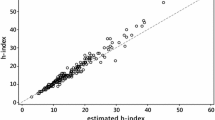Abstract
The Hirsch citation index h is nowadays the most frequently used numerical indicator for the performance of scientists as reflected in their output and in the reaction of the scientific community reflected in citations of individual contributions. A few of the possible improvements of h are briefly reviewed. Garfield’s journal impact factor (IF) characterizes the reaction of the scientific community to publications in journals, reflected in citations of all papers published in any given journal during the preceding 2 years, and normalized against all citable articles during the same period. Again, a few of the possible improvements or supplements of IF are briefly reviewed, including the journal-h index proposed by Braun, Glänzel, and Schubert. Ascribing higher weighting factors to citations of individual papers proportionally to IF is considered to be a misuse of useful numerical indices based on citations. At most, one could turn this argument on its head and one can find reasons to ascribe an inverse proportionality relative to IF for individual citations: if a paper is considered worthy to be cited even if it was published in a low-IF journal, that citation ought to be worth more than if the citation would have been from a higher-impact journal. A weight factor reflecting the prestige of the citing author(s) may also be considered.
Similar content being viewed by others
References
Aguillo, I. F. (1996). Increasing the between-year stability of the impact factor in the Science Citation Index. Scientometrics, 35, 279–282.
Balaban, A. T. (1996). How should citations to articles in high- and low-impact journals be evaluated, or what is a citation worth? Scientometrics, 37, 495–498.
Balaban, A. T. (2011). A. T. Balaban’s autobiographical notes: 80 years of age, 68 years of chemistry. MATCH Communications in Mathematical and Computational Chemistry, 66, 7–32.
Balaban A. T. (2012). Chemical graph theory, and the Sherlock Holmes Principle. Hyle (in press).
Bornmann, L., & Daniel, H. D. (2007). What do we know about the h index? Journal of the American Society for Information Science and Technology, 58, 1381–1385.
Braun, T. (Ed.). (2007). The impact factor of scientific and scholarly journals: its use and misuse in research evaluation (Vol. 2). Budapest: Scientometric Guidebooks Series.
Braun, T., Glänzel, W., Schubert, A. (2006). A Hirsch-type index for journals. Scientometrics 69, 169–173, reprinted in: Braun, T (Ed.) The Hirsch-Index for Evaluating Science and Scientists. Its Uses and Misuses. Scientometrics Guidebooks Series, Vol. 3 (pp. 163–168). Budapest: Akadémiai Kiadó.
Campbell, P. (2008). Escape from the impact factor. Ethics in Science and Environmental Politics, 8, 5–7.
Egghe, L. (2006). Theory and practice of the g-index. Scientometrics, 69, 121–129.
Egghe, L. (2010a). The Hirsch-index and related impact measures. In B. Cronin (Ed.), Annual review of information science and technology (Vol. 44, pp. 65–114). Medford: Information Today, Inc.
Egghe, L. (2010b). Letter to the editor: On Randić’s H-sequence. Scientometrics, 84, 795–797.
Falagas, M. E., Pitsouni, E. I., Malietzis, G. A., & Pappas, G. (2007). Comparison of PubMed, Scopus, Web of Science, and Google Scholar: Strengths and weaknesses. The FASEB Journal, 22, 338–342.
Fersht, A. (2009). The most influential factors: impact factor and eigenfactor. Proceedings of the National Academy of Sciences of the United States of America, 106, 6883–6884.
Garfield, E. (1972a). Citation analysis as a tool in journal evaluation. Science, 178, 471–479.
Garfield, E. (1972b). The impact factor. Current Contents, 10(25), 3–8.
Garfield, E. (1994). The Thomson Reuters impact factor. http://thomsonreuters.com/products_services/science/free/essays/impact_factor.
Garfield, E. (1999). Journal impact factor: a brief review. Canadian Medical Association Journal, 161, 979–980.
Garfield, E. (2006). The history and meaning of the journal impact factor. Journal of the American Medical Association, 295, 90–93.
Garfield, E. (2009). The multi-dimensionality of journal impact. Scientometrics, 78, 355–374.
Glänzel, W. (2006). On the opportunities and limitations of the H-index. Science Focus, 1, 10–11.
Harzing, A. -W. (2007). Publish or Perish. http://www.harzing.com/pop.htm.
Harzing, A.-W. (2010). The Publish or Perish Book. Your guide to effective and responsible citation analysis. Melbourne: Tarma Software Research Pty Ltd.
Hirsch, J. E. (2005). An index to quantify and individual’s scientific research output. Proceedings of the National Academy of Sciences of the United States of America, 102, 16569–16572.
Hirst, G. (1978). Discipline impact factors: a method for determining core journal list. Journal of the American Society for Information Science, 29, 171–172.
Hood, W.W., & Wilson, C.S. (2001). The literature of bibliometrics, scientometrics, and informetrics. Scientometrics 52, 291–314, reprinted (2006) In R. Braun, E. Garfield (Eds.), Evaluations of Individual Scientists and Research Institutions (pp. 3–26). Budapest: Akadémiai Kiadó.
Randić, M. (2009). Citations versus limitations of citations: beyond Hirsch index. Scientometrics, 80, 809–818.
Schubert, A., & Braun, T. (1996). Cross-field normalization of scientometric indicators. Scientometrics, 36, 311–324.
Simons, K. (2008). The misused impact factor. Science, 322, 165.
Vanclay, J. K. (2009). Bias in the journal impact factor. Scientometrics, 78, 3–12.
Vanclay, J.K. (2012). Impact factor: outdated artifact or stepping-stone to journal certification? Scientometrics (in press).
Williams, G. (2007). Should we ditch impact factors? British Medical Journal, 334, 568.
Author information
Authors and Affiliations
Corresponding author
Rights and permissions
About this article
Cite this article
Balaban, A.T. Positive and negative aspects of citation indices and journal impact factors. Scientometrics 92, 241–247 (2012). https://doi.org/10.1007/s11192-012-0637-5
Received:
Published:
Issue Date:
DOI: https://doi.org/10.1007/s11192-012-0637-5




